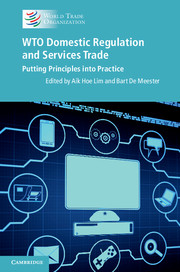Book contents
- Frontmatter
- Contents
- List of contributors
- Foreword
- Disclaimer
- Acknowledgements
- List of abbreviations
- 1 An introduction to domestic regulation and GATS
- Part I Impediments to services trade, regulatory theory and principles
- Part II Legal perspectives on WTO principles and domestic regulations
- Part III Case studies
- 8 Legal services in the United States
- 9 Telecommunications reform in China: fostering competition through state intervention
- 10 Information communications technology: the Mauritian experience of regulation and reform
- 11 Regulation of postal services in a changing market environment: lessons from Australia and elsewhere
- 12 Mobile money services provision in East Africa: the Ugandan experience
- 13 Financial services liberalization and regulation in Japan: implications for future negotiation on market access and domestic regulations
- 14 Domestic regulations in Malaysia’s higher education sector
- 15 Domestic regulations and India’s trade in health services: a study of hospital and telemedicine services
- 16 Operating integrated logistics services in a fragmented regulatory environment: what is the cost?
- 17 Domestic regulation of retail food distribution services in Israel: the missing link between food prices and social protest
- 18 Regulatory impact analysis: addressing the trade and regulatory nexus
- Part IV Concluding remarks
- Index
- References
9 - Telecommunications reform in China: fostering competition through state intervention
Published online by Cambridge University Press: 05 April 2014
- Frontmatter
- Contents
- List of contributors
- Foreword
- Disclaimer
- Acknowledgements
- List of abbreviations
- 1 An introduction to domestic regulation and GATS
- Part I Impediments to services trade, regulatory theory and principles
- Part II Legal perspectives on WTO principles and domestic regulations
- Part III Case studies
- 8 Legal services in the United States
- 9 Telecommunications reform in China: fostering competition through state intervention
- 10 Information communications technology: the Mauritian experience of regulation and reform
- 11 Regulation of postal services in a changing market environment: lessons from Australia and elsewhere
- 12 Mobile money services provision in East Africa: the Ugandan experience
- 13 Financial services liberalization and regulation in Japan: implications for future negotiation on market access and domestic regulations
- 14 Domestic regulations in Malaysia’s higher education sector
- 15 Domestic regulations and India’s trade in health services: a study of hospital and telemedicine services
- 16 Operating integrated logistics services in a fragmented regulatory environment: what is the cost?
- 17 Domestic regulation of retail food distribution services in Israel: the missing link between food prices and social protest
- 18 Regulatory impact analysis: addressing the trade and regulatory nexus
- Part IV Concluding remarks
- Index
- References
Summary
Introduction
As in many developing countries, the telecommunications services sector in China has for a long time been monopolized by the state through the Ministry of Post and Telecommunication (MPT). Established in 1949, the MPT is not only the regulator of telecommunications services, but also the sole owner and operator. Not surprisingly, such monopoly has resulted in the slow growth of the sector. However, such slow growth did not cause major problems in the first thirty years following the founding of the People’s Republic of China because there was little mobility among the population, thus little need for long-distance communication. During this period, the telephone was an exclusive luxury available mostly to the government and the military.
As the country started its economic reform in 1979, however, the telecommunications sector started to drag economic growth down. To solve the problem, the Central Committee of the Communist Party of China and State Council issued two directives in 1984 to encourage the development of the telecommunications sector. Recognizing the special importance of telecommunications in the economy, these two directives made the development of the sector a priority, and launched the first of the many waves of reforms to come. Together, these reforms have transformed China, in a mere two decades, from a country with one-tenth of the world’s average telephone density (teledensity) level into a country with the highest number of telecommunications networks and subscribers in the world.
- Type
- Chapter
- Information
- WTO Domestic Regulation and Services TradePutting Principles into Practice, pp. 142 - 158Publisher: Cambridge University PressPrint publication year: 2014



